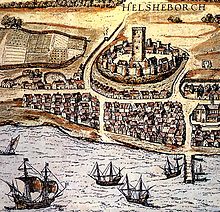
The Treaty of Stralsund ended the Danish-Hanseatic War between the Hanseatic League and the kingdom of Denmark. The Hanseatic League reached the peak of its power by the conditions of this treaty.

Christopher of Bavaria, was King of Denmark, Sweden (1441–48) and Norway (1442–48) during the era of the Kalmar Union.

Magnus Eriksson was King of Sweden from 1319 to 1364, King of Norway as Magnus VII from 1319 to 1355, and ruler of Scania from 1332 to 1360. By adversaries he has been called Magnus Smek.
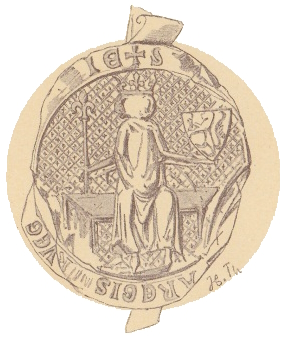
Haakon VI, also known as Håkan Magnusson, was King of Norway from 1343 until his death and King of Sweden between 1362 and 1364. He is sometimes known as Haakon Magnusson the Younger to distinguish him from his great-grandfather, Haakon V.

Valdemar IV Atterdag, or Waldemar was King of Denmark from 1340 to 1375. He is mostly known for his reunion of Denmark after the bankruptcy and mortgaging of the country to finance wars under previous rulers.
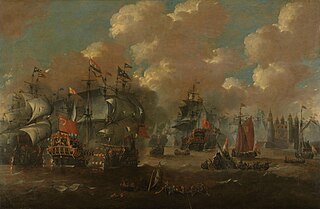
The Battle of the Sound was a naval engagement which took place on 8 November 1658 during the Second Northern War, near the Sound or Øresund, just north of the Danish capital, Copenhagen. Sweden had invaded Denmark and an army under Charles X of Sweden had Copenhagen itself under siege. The Dutch fleet was sent to prevent Sweden from gaining control of both sides of the Sound and thereby controlling access to the Baltic Sea as well as of its trade.
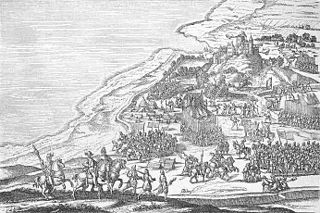
The Northern Seven Years' War was fought between the Kingdom of Sweden and a coalition of Denmark–Norway, Lübeck, and Poland–Lithuania between 1563 and 1570. The war was motivated by the dissatisfaction of King Frederick II of Denmark with the dissolution of the Kalmar Union, and the will of King Eric XIV of Sweden to break Denmark's dominating position. The fighting continued until both armies had been exhausted, and many men died. The resulting Treaty of Stettin was a stalemate, with neither party gaining any new territory.

The Duchy of Estonia, also known as Danish Estonia, was a direct dominion of the King of Denmark from 1219 until 1346 when it was sold to the Teutonic Order and became part of the Ordensstaat.
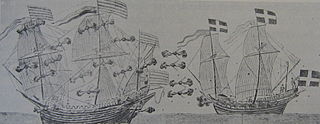
This battle in the Northern Seven Years' War took place on 7 July 1565 and was a decisive victory for a Swedish fleet of 49 ships, under Klas Horn, over a combined Danish and Lübecker fleet of 36 ships, under Otte Rud.

The Battle of Helgeå, or Battle of the Holy River, was a naval engagement which took place in 1026 between joint Danish and English forces and a combined Norwegian and Swedish force, at the estuary of a river called Helge in Sweden or Denmark.

Herluf Trolle was a Danish naval hero, Admiral of the Fleet and co-founder of Herlufsholm School, a private boarding school at Næstved on the island of Zealand in Denmark.
The Military timeline of Denmark is centered around an involvement in wars in Northern Europe since 793 and, recently, elsewhere.

The Confederation of Cologne was a medieval military alliance formed to combat the Kingdom of Denmark. It was established on November 19, 1367 by several cities in the Hanseatic League, several cities in Holland, Zeeland and Zuiderzee.

The Battle of Bornholm was a naval engagement that took place in June 1535. The conflict saw Lübeck and the Hanseatic League engaged against the forces of Sweden, Prussia, Holstein, and Denmark. The Battle of Bornholm was part of the larger Count's Feud.

Johann Wittenborg was a merchant and mayor of the free port of Lübeck in what is now north Germany. He was admiral of the Hanseatic fleet at the Battle of Helsingborg and was tried and beheaded after losing this battle.

Christopher, Duke of Lolland, was the son of King Valdemar IV of Denmark and his wife, Helvig of Schleswig. Christopher was appointed duke in 1359 and also was selected to succeed as king.

The Dano-Hanseatic War, also known as the Kalmar War with the Hanseatic League, or the Danish-Hanseatic War of 1426-1435, was an armed trade conflict between the Danish-dominated Kalmar Union and the Hanseatic League led by the Free City of Lübeck.

During the Danish-Hanseatic War (1426–1435) the Danish capital Copenhagen was bombarded twice by ships from six Northern German Hanseatic towns. A first attack in April 1428 was repelled, a second attack on 15 June was successful. The Danish fleet which anchored in Copenhagen was destroyed. For the first time in the Northern European history of naval warfare ship artillery was used over longer distances.

The Danish–Hanseatic War (1361–1370) was both a trade and territorial conflict mainly between the Kingdom of Denmark, led by King Valdemar IV, and the Hanseatic League, the latter of which was led by the rich and powerful merchant city of Lübeck. Though the first few years of the war resulted in several Danish victories, and even led to a beneficial truce for Denmark in 1365, the Hanseatic League, furious at the terms of the truce, resumed hostilities along with several allies and managed to defeat the Danes.

The Siege of Copenhagen or the Capture of Copenhagen, was a looting and siege of Copenhagen and Absalon's Castle in 1368 between Denmark and the Hanseatic League, during the Danish-Hanseatic War (1361–1370). The city was looted and Absalon's castle was destroyed.
